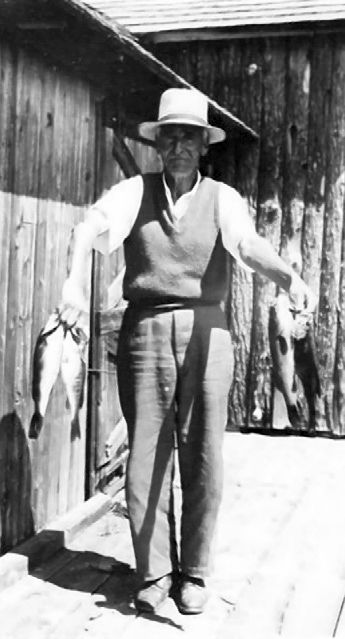
Fishin’ with Charles, Part II

Belgrade Lakes, August 1, 1939 — Welcome back readers, we hope you enjoyed last week’s “Fishin’ with Charles” story. Let’s pick up where we left off!
With Charles and the Rauses aboard, the 24-foot guideboat exited Mill Stream into Great Pond. Charles deftly turned the side mounted ship’s wheel and the sleek old lapstrake craft slowly came around to port and headed her nose to north. A light chop slapped away at the bow as Charles knocked the throttle back to low idle and passed the fly rods to Albert and Blanche. Today’s fishing would begin with trolling streamer flies on light rods. Charles liked to give his sports an easy start in the shallow waters but later would switch over to strong trolling rods loaded with lead core line and sewed-on bait. This morning Blanche dragged a Blue Smelt and Albert a Gray Ghost.
Charles slid the kill switch over to the closed position as he prepared to begin rowing. Even at the slowest idle, the boat would not go slow enough to troll for salmon and trout. The old Kermath engine died out, but as the big open flywheel came to a halt, it belched one last THAW-HAW. Silence was upon them until Charles started his rhythmic slow rowing, and the leather wrapped oars lightly groaned in the brass oarlocks.
As the morning wore on and both sports had landed several smaller bass near Dry Point shoal, Charles steered the boat into much deeper water and prepared the heavy tackle. The previously prepared leaders, about 3 feet long, contained sewn-on white perch of about 4 inches. These were skinned in the early morning as part of Charles’s preparations, then sewn on to the double hook leaders with tiny copper wire. A slight curve was formed to make the baitfish appear to be swimming, an assumption here that the salmon and trout would approve and be likely to go for it. Time and experience had proven this method to be a winner.
After the lead core line was slowly eased out, the “deep rig″ slowly went down to about 50 feet. To keep the rig from hitting the bottom, Charles had to row considerably harder. It was his plan to row over the deepest spot in the lake, just off from the northwest side of Hoyt’s Island. With the waters being warmer this time of year, most of the larger salmon looked for deeper, cooler waters to survive in. After two passes over the deep hole, Charles’s old arms had had enough. For today, the salmon would stay in the lake. After reeling in the long heavy lines, the Rauses too were ready to take a break.
Noon was approaching and the next stop would be Oak Island. A previously arranged rendezvous with the other sports and guides Ellis, Rix, and Johnson would include a nice lunch around a small campfire. The fish chowder, now riding in the stainless steel bucket with cover under Charles’s seat, would be heated and shared by all. It was made the previous day at the Locust House kitchen, something that Ed Megill and his staff did on a regular basis. Most guideboats, including Charles’s, had been fitted with a tin lined box where a small block of ice was put each outing. After a 15 minute ride powered by the Kermath, Charles brought the Stewart built boat to a crude dock the guides had fashioned for sports to disembark onto Oak Island. The picnic spot had been carved out many years before by the guides and was generally kept neat and tidy by all that used the spot.
After a good long lunch and rest, the sports and guides reboarded their respective crafts. On the way home this early afternoon, Charles would stop at the White Ledges, where Blanche and Albert could standup in the boat and do some fly casting, likely to get their fill of bass and perch. This would round-out the day, except for brisk ride home with the old Kermath supplying the power. All three occupants would be glad to reenter the stream and call it a day. The 20-year-old guideboat had been in and out of Mill Stream a good many times with Charles at the helm. Once more he slithered the old craft through the narrows and glided into his same old slip at the Association Docks, just like a thousand times before.
Author’s Note: Mr. and Mrs. Charles S. Brown purchased the “stone house” in the middle of Belgrade Lakes village in 1922, when it was a store owned by Harrison Harnden. After major renovations (cutting in window holes by stone masons) the Browns made it their home until the early 1960s. Charles S. Brown passed away in 1961. (The information in this note came from a small history of Belgrade Lakes by Charles’s son Leslie Brown given to and property of the Belgrade Historical Society.)
Rod Johnson was born and raised in the Belgrade Lakes in the 1950s and ’60s.
Download Full Newspaper: High Res | Low Res (Details…)
<— Previous Article • Summaries • Next Article —>
©2022 by Summertime in the Belgrades. All rights reserved.